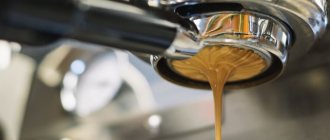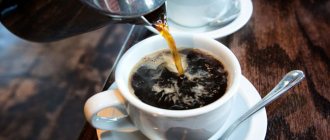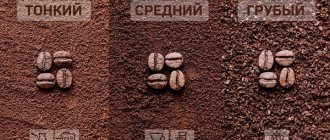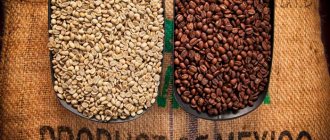Espresso... It would seem like strong, black coffee, what difficulties could there be? But they exist, and preparing this drink correctly is not so easy, even using modern technology. Whatever the coffee machine, it will not be able to brew coffee without your participation.
It is important to set up the equipment correctly, keep it clean and follow the operating rules. Another important factor is the choice of raw materials, adherence to dosage and accuracy in preparation time. Now let's talk about everything in order.
Setting up the coffee machine
This is an important preparatory step on the way to the perfect espresso. To keep your equipment running like a clock, follow a few simple rules:
- Before starting work, clean all containers from dust;
- connect the device to power and water supplies (water supply is not required for all models);
- turn on the device;
- fill the reservoir with cold water;
- set the desired heating level;
- when the water reaches the desired temperature, drain it;
- set the volume of liquid per serving and the water hardness level;
- if there is a grinding function, adjust the coffee powder fraction;
- set the volume of one serving of the finished product;
- start the cooking program.
Used tablet
If the coffee tablet was inserted correctly, it should not have any breaks or cracks before being removed. There will be a clear imprint of the screw on it. The tablet should be easily removed from the holder and not crumble. The consistency is very similar to plasticine.
Interesting notes:
- If the grind is fine, the tablet will have excess water on the surface and will not have a nice shape.
- If grinded coarsely, the tablet will be very dry, crumbly and brittle.
And in the end, I would like to say that the freshness of coffee beans can be easily determined by their oily coating.
Selecting raw materials
Choosing the right bean is the key to success in making delicious espresso. For the classic version of this drink, use the Arabica variety or a mixture of Arabica and Robusta. In the first case, the taste of the finished product will be soft, in the second - tart, with bitterness. Roasting grain should be dark. The type of roasting for espresso is also called “Italian” - this grain is very dark, almost black. At the same time, beans from coffee blends that contain Robusta should be slightly lighter.
Dark roast beans are used exclusively for coffee machines. Baristas do this so that the taste of the coffee acquires a sweetish, rich hue. Light grains can produce excess acidity and wateriness.
Bean storage and grinding
Whole coffee beans should be stored in the coffee grinder hopper for no more than a day. After some time, they greatly lose their taste due to constant interaction with oxygen.
Important!!! Do not keep the coffee grinder on for more than 1 minute. Otherwise, the espresso will taste dry and burnt.
Each coffee grinder has its own grinding settings. Try to constantly adjust them regarding humidity. When the humidity is high, grind a little coarser; when the humidity is low, reduce it. Remember that the grind size is affected by the freshness of the beans, air humidity and the condition of the knives in the coffee grinder.
Making classic espresso
There are several factors to consider when preparing this type of coffee. And each barista, after many years of experience, comes to his own, individual technology: some use longer extraction, others experiment with roasting and the type of raw material. But in any case, they all rely on the classic recipe, which contains the basics of making the perfect espresso:
- The extraction lasts 25 seconds. Until you learn how to make espresso with your eyes closed, stick to this interval;
- The amount of ground coffee depends on your portafilter basket. Typically, one standard serving requires 7-10 grams, for a double serving - 16-20 grams;
- The volume of one serving of the finished product is 25-35 ml;
HELP: The amount of water when preparing espresso in a coffee machine does not matter.
A few more important parameters, the observance of which will lead you to the pinnacle of mastery:
- Water pressure. The optimal working pressure is considered to be 8.2-9 atmospheres. To adjust it, prepare a tablet, insert it into the holder and turn on the flow. Pay attention to the monometer and adjust the desired value. During further use, also periodically monitor the numbers on the scale.
- Water temperature . Espresso beans are roasted to a specific temperature, and it is best to adhere to this value. 93 degrees is considered optimal. If the model of your coffee machine does not provide for setting the temperature with an accuracy of a degree, and the adjustment is made with a bolt on the pressure switch, be guided by experience based on the taste of the finished product. Too acidic - we increase the temperature, sharply bitter - we lower it.
- Coffee dosage and portafilter volume . When choosing a basket, give preference to a double one. The extraction is more stable in them. The double basket contains from 16 to 21 grams. ground coffee, depending on its volume. Usually the dosage is indicated on the basket itself and must be strictly followed. If you decide to make a drink from 16 grams of coffee in a basket designed for 21 grams, you will not be happy with the result. If there is no marking, then be guided by the size of the coffee tablet: it should not reach the dispersion mesh slightly.
- Tempering . When making espresso, it is important that the water flows evenly through the entire coffee tablet. To do this, the tablet must be equally dense throughout its entire volume, without lumps, inclusions or voids. Distribute the coffee evenly in the basket and tamp it down with a tamper, avoiding distortion of the tablet. Choose a tamper with a flat base and a diameter close to the size of the basket.
- Extraction . Before installing the holder into the coffee machine, pour 50-100 ml. water. In units with a heat exchanger, this is done in order to reduce the temperature, and in double-boiler units, this is done to clean the mesh from the remnants of previous cooking. Now install the holder and start cooking. The quality standard is considered to be an espresso weighing 36 grams, prepared from 18 grams of ground beans, in 27 seconds at a temperature of 93 degrees. These parameters can be changed depending on the characteristics of a particular coffee machine. IMPORTANT: As soon as you have installed the holder, immediately turn on the pour; a pause at this stage will distort the taste of the finished product, and most likely not for the better.
- Adjusting the taste. Have you prepared espresso following all the recommendations, but its taste is not perfect? There are several ways to correct the situation:
- If the coffee is too sour, increase the yield of the finished drink, increase the temperature or extraction time;
- If there is a lot of bitterness, reduce the yield, reduce the temperature or extraction time.
IMPORTANT: When adjusting the flavor, only change one parameter at a time, otherwise you may overdo it and then have to go back to square one and start over.
Practical setup
For the sake of an example, I will analyze the setup directly for our coffee shop. At the moment we are using Brazil Serado grain from tasty coffee . Coffee suppliers recommend the following parameters for double espresso: bookmark - 17 grams, espresso weight 33 grams, extraction time 25 seconds.
We have an automatic coffee grinder, in which the grind size is programmed and a coffee machine with the ability to configure automatic dispensing according to a given volume of espresso.
Initial experiments on setting up espresso gave us 60 grams of drink. It was very sour. Reducing the grinding, we finally got to 33 grams. Balanced taste, sourness pleasantly transitions into chocolate bitterness. But it was coffee on the brink. Due to the grinding being too fine, the coffee grinder produced errors of one gram of coffee per load. If you overtemper a little, the coffee will hardly flow at all.
At the same time there was another problem. Based on the volume of milk drinks, the taste of coffee began to be lost against the background of milk. Well, imagine, the average cappuccino is 340 ml, prepared with double espresso. That is, 33 grams of coffee, and the rest is milk.
To solve both problems, the following steps were taken: the coffee load was increased from 17 to 19 g, the grind was increased, and the extraction time was increased from 25 to 28-29 seconds. Thus, we received an increased portion of double espresso of 42-45 grams. The taste of the espresso itself has not changed relative to the original. Dairy drinks have become better able to convey the taste of coffee. We did the same with all volumes of drinks.
While testing the espresso at the beginning and throughout the shift, I noticed that the settings would periodically shift, either due to room temperature and humidity, or small changes in group pressure. Such changes are most often temporary, so it is convenient to compensate for them by tempering without touching the grinding again.
Several recipes
Espresso is not only an independent drink with a viscous texture and rich taste. It is also the basis for making many coffee cocktails. In this case, how tasty your cocktail will be directly depends on a well-prepared espresso. Let's prepare the classic and double versions step by step.
For you:
Introducing the cold brew drink
Classical:
- Measure out 7-10 grams of ground coffee.
- Pour into the holder and tamp down.
- Turn on espresso mode.
- The coffee will be ready in 30 seconds.
IMPORTANT: The espresso cup must be hot. Most modern units heat dishes depending on the selected program. If your coffee machine does not have this function, pour boiling water over the cup before starting to brew.
Doppio (double):
Doppio is essentially just a double portion. Therefore, the cooking process does not differ from the classic recipe, but we increase the amount of grain in accordance with the volume of the basket. Usually it is 16-20 gr.
How to drink espresso correctly?
Presentation matters. It is best to drink espresso according to the canons invented by the Italians - from small porcelain cups with thick walls, called demitasse. Such utensils allow you to keep coffee hot for as long as possible and maintain its flavor and aroma properties.
Espresso is served to the table no later than one and a half minutes after preparation. It is believed that this drink should be drunk while it is hot, and most coffee lovers adhere to this point of view. However, in reality there are no hard and fast rules on this matter: if you want to wait until the coffee cools down, that is your sacred right.
Another important feature is that espresso must be accompanied by a glass of clean water, a sip of which before drinking coffee helps to refresh the receptors and remove from the tongue all unnecessary tastes from the food eaten the day before. If you are not served a glass of water with your espresso in a cafe, this is a reason to raise an eyebrow in confusion and doubt the quality of service.
The second important component when serving espresso is sugar. Whether or not to add it to a drink is a personal choice, but the right approach certainly means having sugar next to your cup of coffee.
If you want to complement the espresso with some kind of treat, you can safely do this using chocolate (especially dark), sweet fruits and berries, as well as cakes and cookies with a sweet taste. But avoid drinking meat snacks, vegetables and sour treats with this type of coffee. Wine and beer also do not go well with espresso, unlike traditional Italian grappa.
Signs of technology violation
- The color of the foam should be a transition from golden to brown. If the foam is lighter, most likely there was not enough time for high-quality extraction.
- A black ring and white bubbles indicate that the dosage of ground grain has been exceeded, the temperature is too high, or the raw material fraction is too small.
- The foam is unstable and quickly disappears after preparing the drink - the coffee beans are not roasted enough.
Start with strict adherence to technology and experiment as you gain experience. Perhaps very soon you will be teaching someone how to make the perfect espresso.
Turkish espresso coffee recipe
Despite the complexity of making espresso coffee, you can also get an aromatic, invigorating drink with thick golden foam at home. To do this, just follow a few rules.
To prepare espresso in a Turk you will need the following ingredients:
- coffee powder - 2 teaspoons;
- sugar - 2 teaspoons;
- salt - on the tip of the knife;
- water - 30 ml.
How to brew espresso coffee correctly? Pour sugar, salt, ground coffee beans into the Turk and mix everything thoroughly. The turk is heated over low heat until a characteristic aroma appears, and then preheated water is added.
As soon as bubbles appear on the surface and the foam begins to rise rapidly, you should immediately remove the Turk from the stove. After a few seconds, when the head of bubbles has settled, the coffee is again put on low heat and waiting for the foam to appear. If you bring it to a boil several times, a thick and stable foam forms on the surface.
Double espresso, lungo, Americano, ristretto and other types of drinks based on the classic recipe are prepared in the same way.
How to cook at home
The simplest recipe for making espresso at home is as follows:
- Instant coffee and granulated sugar are poured into a cup with thick walls in the quantities usually used for one serving.
- Next, add a little boiling water to the cup and vigorously beat the resulting mixture with a spoon.
- After some time, the mass will lighten and acquire the consistency of sour cream.
- Gently add the remaining water to the whipped mixture, stirring slowly until a thick foam forms.
In addition to espresso, you can prepare various versions of the drink at home based on the classic recipe. In this case, the same technology is used, only the amount of ingredients changes. We invite you to try the following recipes:
- Double espresso or doppio. Prepared from double the amount of sugar, coffee powder and water.
- Ristretto. Lovers of strong drinks will like this coffee. The volume of water is left the same, but the amount of powder and sugar is doubled.
- Lungo. The recipe calls for increasing the volume of water from 30 to 50 ml.
- Americano. By increasing the amount of water, the serving volume is increased to 120 ml.
You can also diversify the taste of traditional espresso with various additives:
- Macchiatto. A little warmed milk and whipped until foamy is added to the cup.
- Konpanna. A small amount of cream is added to a shot of traditional espresso and the foam is sprinkled with grated chocolate.
- Coretto. A small amount of liqueur is added to the finished coffee.
- Glasse. Ice cream is added to coffee that has cooled to +10 degrees in a 3:1 ratio, and the finished drink is sprinkled with grated chocolate or cinnamon.
- Latte. A portion of coffee prepared using classical technology is carefully poured into a cup of heated and frothed milk.
When did espresso appear?
Espresso, a 40-milliliter shot of a rich drink with light brown crema, and its milky derivatives are so common that they seem to be coffee's dominant form of existence. They fill the menus of most restaurants, chain coffee shops and even street vending machines. Other fans prepare coffee using home equipment. However, outside of Italy, espresso was only discovered after World War II, and the first modern espresso machine appeared only a little over a century ago.
In 1901, Milanese engineer Luigi Bezzera brought to fruition previous developments and patented an “Advanced device for preparing and immediately serving coffee drinks.” The method and the coffee itself were named because of the principle of operation of the Bezzera unit. Pressurized water and steam seep through the ground and pressed beans, extracting the caffeine and flavor compounds into the cup. Over the course of more than a hundred years, the appearance of the machines has changed somewhat, but, in essence, the drink is brewed in exactly the same way.
Coffee beans are obtained from the berries of shrubs of the madder family: Coffea arabica (Arabica) and Coffea canephora (Robusta). A ripe drupe berry turns red when ripe and looks like both a cherry and a dogwood.
Gleb Smirnov
Venetian hermit, cultural theologian
It turned out that I was more addicted to tea, but the unscrupulousness and double-dealing inherent in people sometimes lead to the fact that even apostates from coffee like me still drink it. Let's say, extremely rarely, but with enormous pleasure. This happens at such moments when you want to drop everything and sit in the sun in some cafe with the right view, for example on the southern embankment of Zattere, when on your right hand you can see a sunset of exceptionally high-quality colors - and order a cup.
Philip Avdeev
actor
When I was little, all the adults drank coffee all the time, and there was a feeling that this was such a serious drink for serious people. As a child, this black coffee was, in my perception, some kind of unusual drink that I had not grown up to. But I drank coffee with milk and sugar, apparently it was a children's option, like children's champagne. But now I’m not so small anymore, and black coffee is no longer forbidden fruit for me, and my desire to drink it has strangely disappeared. But sometimes I still join the coffee lovers and drink it to cheer myself up. One cup of black coffee in the morning after a sleepless night is enough for me to activate my brain and feel cheerful. If I drink more than one, my central nervous system goes out of control.
How to check the quality of the finished drink?
The main criterion is taste: a harmonious combination of sweetness and bitterness, sourness and saltiness. If you notice the taste of burnt milk or overcooked grains, it is better to avoid consumption.
When properly brewed espresso is poured into a cup, the stream is dense, even slightly oily. But this is only a visual impression. After 2-3 minutes, when the grounds settle, a stable, dense foam forms on the surface of the cup. Its color can vary from nut to chocolate.
Where to find good coffee
Although there is a stereotype that the best espresso can only be made by a skilled barista with industrial equipment, you can brew delicious coffee yourself. First of all, it is important to choose high-quality raw materials. Coffee must be hermetically packaged so that it does not lose its flavors and aromas, so we do not recommend coffee beans that are sold without packaging. Also, be careful when purchasing ground coffee, always check the grinding date, otherwise you risk limiting your enjoyment of the tasting itself. Pay due attention to the choice of coffee machine. It must meet the parameters for preparing espresso: pressure of at least 15 bar. And, of course, don’t forget about the utensils that will help complement the moment of coffee tasting. For espresso, a 40-60 milliliter cup made of porcelain or other material that maintains the temperature of the drink is ideal.











